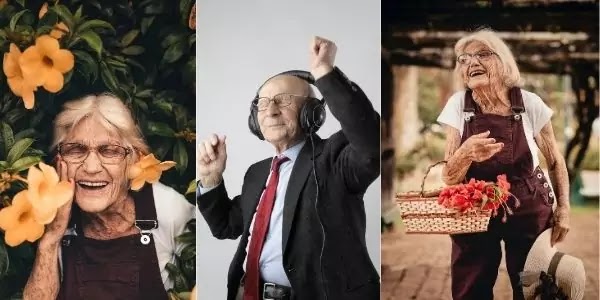How Your Health Is Affected During the Three phases of Old Age
With the advancement of medical technology and the adoption of healthy lifestyles, life expectancy is increasing, which means that the number of older people as a percentage of the population is also increasing.
An older community is a community where more than 7% of people are 65 years of age or older.
The elderly community is the one over 14% of people over the age of 65, too
In an overly old society more than 20% or older people.
Our planet is aging rapidly
It took almost 110 years for the number of people over the age of 65 in France to rise from 7% to 14% of the total population. The same process lasted about 80 years in Sweden, about 50 years in the United Kingdom, and 20 years in Brazil and Korea.
So what does this mean for those of us who are already over 65 years old?
As we grow older, our body and mind weaken and disease progresses. Chronic illness, muscle weakness, and mental retardation are more common in the elderly.
Surprisingly, the elderly make up a significant portion of the medical expenses of any community in which they live.
In 2015, for example, the percentage of people aged 65 or older in South Korea was 13.2% but their medical expenses accounted for 36.5% of the national average of health care.
You should therefore pressure your government to ensure that health care systems are in line with the needs of older persons.
Studies in Europe and North America show that older people have an average of four to four diseases, far more likely than most adolescents.
Older people suffer from medical conditions, such as heart attacks, strokes and cancer, often because their lungs, and their cardiovascular systems and their immune system deteriorate along with their immune system.
Unhealthy eating also contributes to the loss of good health in the elderly. Therefore, you should make sure that you eat nutritious food to maintain your health as you grow older.
Age classification
Until recently, a number of older studies have divided people over the age of 65 into one group.
As humans live longer, scientists find that diseases vary depending on how long people live after 65 years. As a result, researchers now divide old age into three distinct periods:
65 to 74 years … the youngest
75 to 84 years … average
over 85 years … the oldest
So what is the difference in health and well-being between the three age groups?
—
Osteoporosis
Osteoporosis is a disease in which your bones suddenly break and become weak. They often break when you fall or have a bad bump. The most common fracture due to osteoporosis is that of the waist, back and wrist.
Osteoporosis may develop as you get older. This can be seen in the increasing level of hospital admissions for orthopedic surgery in the elderly.
A study by researchers in Australia found age-related osteoporosis in 20% of 50-year-old patients, 46% of 60-year-olds, 59% of 70-year-old patients, and 69% of patients aged over 80 years. If you are in the oldest group, you may have osteoporosis.
Therefore, if you are over the age of 65, you should get tested for osteoporosis regularly. There are several treatments you can follow to prevent your osteoporosis from getting worse.
Fall
Fall among the elderly is common. One of the major causes of falls is syncope, which means fainting or death due to a temporary decrease in the amount of blood flowing to your brain.
You can get syncope if your heart rate is abnormal, blood flow to the heart, abnormally low blood sugar levels, you are taking anti-depressants or other low-grade diseases.
A fall can also be caused by blurred vision, intoxication with sleeping pills, and paralysis caused by a stroke or neuromuscular disease (affecting the muscles and nerves that control them).
A sudden fall can have serious consequences, especially if you hit your head or fall on your wrist.
If you are over the age of 65, you should adjust your living quarters so that sliding and falling are less likely and have more serious consequences if they occur.
In addition, you should install an emergency call button, especially if you live alone, connected to a security service that can notify your key holder or emergency services.
Lung function
With age, lung function decreases as the lung capacity and the propensity for the chest to return to its normal state decrease. This causes stiffness of the respiratory muscles.
This explains why respiratory infections are more common in older patients. Indeed, hospital admissions for respiratory problems constitute a major component of internal hospital admissions.
It is clear that older patients should be given respiratory equipment and training in lung function to increase lung capacity and improve breathing.
To strengthen your lung muscles, you should get a respirator, as used by runners and musicians, that resists your breathing and enlarges the four muscles of your lungs. Use it daily and after a few weeks you will find that your breathing will be greatly improved.
You should also stop smoking.
—–
Admission to the hospital
There is a complete difference in hospital admission between the three groups of adults.
Collectively, all three groups make up the largest number of hospitalizations due to internal diseases, but about two-thirds of these older patients.
This is because as you grow older, your immune system weakens and you become more susceptible to infections, cancer, and autoimmune diseases.
Therefore, hospitals and hospital admission plans need to be tailored to the needs of older people who make the most use of these services.
Use of ambulances
Older patients use emergency ambulances more often than younger patients.
Studies show that in most developed countries more than a third of the elderly patients, and about half of patients older than 85 years, use ambulances to get to the emergency department (ED).
In contrast, emergency ambulances are used only in less than 30% of children attending ED.
Therefore, ambulances need to be equipped to meet the needs of older patients.
Duration (LOS) Duration in ED
A recent 0ne study found that older patients live on ED about 20% longer than younger patients with a similar complaint.
Several other studies show that LOS in ED increases with age. This may be because older patients in ED are at greater risk for concomitant infections. They may also need additional diagnostic and emergency treatment, as well as time-consuming consultation with various departments.
One study reports that an increase in LOS among elderly patients is mainly due to hospital waiting times.
Governments need to develop effective policies for managing ED and LOS overcrowding.
Time in the ICU
Some studies indicate that there is no difference in the rate of admission to ICUs between the three groups of older people, but there is a difference in the extent of their stay in the ICU between the youngest and the oldest.
This is because older patients respond better to treatment than older patients.
Women
Numerous studies have shown that women in Europe represent 51% of patients aged 70 to 79 and 61.68% of those over 80 in ED. In a study conducted in South Korea, women accounted for 55.4% of all adult patients, meaning 51.5% younger, 54.9% middle-aged, and 69.1% older.
Therefore, both public health policies and hospital administrators should consider increasing the number of women’s wards and specialized medical services for women.
—
Taking home Message
Eat nutritious food to maintain your health as you grow older.
Regularly check for osteoporosis and, if you have any, follow any treatment that your doctor prescribes
Fix your living quarters so that slip and fall are less likely and have the worst effects possible.
Wear an emergency “panic” button connected to a monitoring service that will notify your key owners or emergency services in the event of a fall or accident.
Exercise your lungs daily with Powerlung or something similar to maintain lung function.
Form an opposition group with older neighbors to encourage political representatives, TDs, Parliamentarians, Senators etc. to ensure that your government does the following:
planning its health care programs and the needs of older people who use these services more than other age groups.
equip ambulances to meet the needs of elderly patients.
to formulate an effective policy for the management of congestion and the length of stay in emergency departments.
considerations, as well as hospital administrators, to increase the number of women’s wards and specialized medical services for older women.






